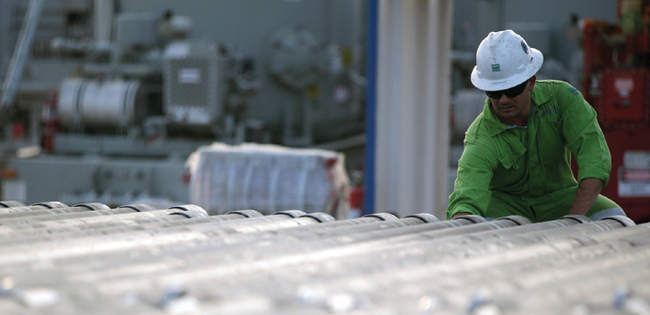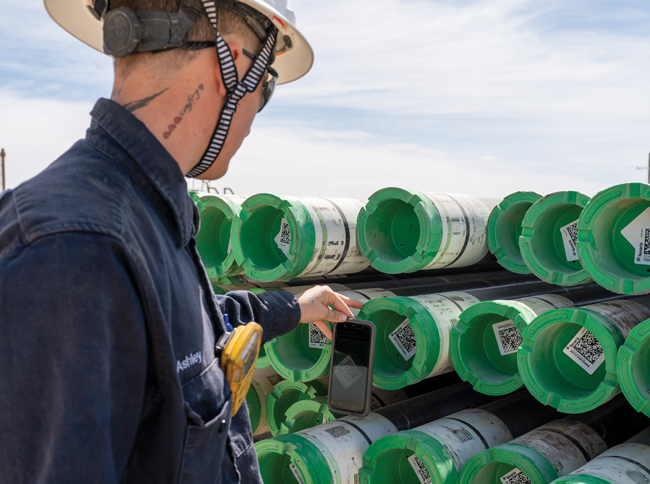
OCTG Manufacturers Partner With Operators To Simplify Pipe Delivery
By Afif Najjar
A streamlined approach to handling oil country tubular goods continues to gain traction. This approach centers on direct relationships between operators and tubular mills aimed at reducing costs and volatility.
These advantages come partly from the insights the closer relationships give the OCTG manufacturer. With more frequent and detailed feedback on operators’ evolving needs, suppliers can link output more closely to demand, which should mitigate the chance of overbuilding or underbuilding stock and smooth fluctuations in OCTG prices.
At the same time, deeper market insights can give OCTG suppliers the confidence to invest in domestic mills and other local infrastructure. Placing production closer to the point of use shortens lead times and streamlines logistics while minimizing the risk international events will disrupt critical domestic activity.
Numerous Benefits
The benefits of collaboration between OCTG manufacturers and operators extend beyond optimizing costs and logistics. When OCTG manufacturers manage the supply chain, they are in the perfect position to integrate services that ease workloads at the rig site. These services help improve quality, traceability and well integrity, support rig site safety, and reduce drilling’s environmental footprint.
The impact of closer relationships has been tremendous. To understand how significant it can be, consider the cost breakdown for drilling a typical well in the United States. Total costs frequently fall somewhere between $5 million and $6 million, with a substantial portion—approximately $800,000 to $1.2 million—allocated to OCTG. Casing, tubing, liners and accessories play a pivotal role in shaping the project’s cost structure and the rig’s financial dynamics. In fact, OCTG often ranks as the second or third largest spend for an onshore shale well.
With that reality in mind, several of the top oil and gas companies in the United States work directly with OCTG suppliers to achieve greater efficiency. This article will dive into OCTG services’ evolution over the past decade to show how integrating OCTG supply and OCTG-related services is yielding substantial cost savings for U.S. operators.
Simplicity Delivered
OCTG manufacturers began taking steps to integrate production and services by adopting a mill-to-well approach in 2015 and inviting operators to partner throughout their drilling projects. From technical consulting and pipe management to delivering products and services in the field, this integrated approach helps operators improve well quality and reliability while reducing inventory obsolescence, working capital costs and total cost of ownership.
By tying oil country tubular good production to operators’ needs, the mill-to-well model is mitigating the price spikes traditionally seen when activity ramps up or needs change. At the same time, the integrated services associated with the model are simplifying rig site operations in plays across the United States.
Under this framework, the operator provides the drilling forecast, and technical support teams from the OCTG manufacturer who have experience in well operations and design actively engage in operational and design discussions. They assist with string design and share knowledge on technologies and materials used in similar environments around the world. Beyond gaining access to the full product range, operators benefit from the convenience of a direct relationship with a fully integrated OCTG manufacturer that can scale its level of support as needed.
Pipe production and accessory management is programmed around the operator’s actual drilling needs, optimizing timing and delivery. Local production and service facilities offer customers shorter lead times and more responsive service capabilities. OCTG components are delivered directly to the well site, minimizing the need for extended storage at yards. Together, these benefits mean operators receive the right product, at the right place, at the right time.
The mill-to-well model also means operators pay solely for the pipe they actually use and need. Typically, distributors order excess pipe to ensure they have stock at the yard when it’s required. These contingencies can be particularly noticeable when importing pipe, as distributors must account for delivery inconsistencies, the risk of quality issues from some sources and long lead times. Additionally, imports from lower-quality suppliers require additional inspections and reviews, further increasing product cost and lead times to the well site.
Under the mill-to-well model, operators avoid paying for surplus pipes, unnecessary safety stocks and additional inspections. In practical terms, they minimize the chance of encountering well integrity concerns, benefit from significant material optimization and face no risk of being stuck with market-standard items.
This approach also provides environmental benefits, as it significantly reduces the amount of pipe manufactured and shifts production to domestic OCTG suppliers that carry a much lower carbon footprint. The lower pipe volumes and direct delivery translate to fewer truck trips to deliver pipe to the rig.
End-to-End Quality Traceability
Well integrity depends on quality at every stage of the supply chain. OCTG manufacturers are in the best position to ensure end-to-end quality: they own the raw material, produce the pipe and manage inventory. This enables delivery of OCTG components to the well in a quality-controlled environment.
End-to-end quality also manifests in product design and performance. Integrated OCTG manufacturers carefully select the composition of the inputs to align with facility capabilities. Since they source and produce all parts for the product rather than combining parts from third parties, they can adjust the design and manufacturing process to achieve the best results. In the field, the extra quality leads to greater reliability and safety.
As a value-added service, an integrated manufacturer began developing digital tools in 2015 to simplify tracking, improve traceability and reduce manual processes. This tool identifies pipes throughout their full life cycle, across industrial processes, supply chain management and on-site operations, including preparation and running.
At the mill, pipes are measured and weighed within API tolerance requirements. For the integrated manufacturer, traceability goes back to the raw material. The thread protector and the pipe wall include QR codes and radio frequency identification tags that contain these measurements, the complete manufacturing history of each pipe, technical specifications and any other necessary certification information.
Through an online application accessible from mobile phones or handheld scanners, operators can create digital tallies, which eliminate the need for manual measurement, reduce pipe handling, improve accuracy and simplify operations. This application has more than 400 monthly users in the United States, who create an average of 700 string e-tallies a month.
Before adopting the digital solution, operators generally needed a six-eight-person crew to receive approximately 20 trucks, take measurements on site and notate pipe specifications for a complete load. The entire process took at least four or five hours. Now, this step can be completed by one or two technicians simply by scanning QR codes.
The QR codes on these thread protectors provide easy access to each pipe’s technical specifications, including running guidelines. Scanning the codes allows one or two people to create digital tallies, eliminating the need for manual measurement.
Code-based traceability also enhances the quality of inventory management and customer dispatches, ensuring delivery of the correct product and quantity with digital confirmation and tracking.
Building on the success of the digital tool, the integrated manufacturer launched an online portal in 2017 to streamline both administrative and operational aspects throughout the entire pipe lifecycle. This portal gives operators digital follow-up and traceability for both current and historical orders, complete with status notifications. Additionally, users benefit from a digital tally summary that provides a consolidated view of each callout, as well as access to customized key performance indicators.
With 98% of the customers working under the mill-to-well service model in the United States using the portal, it averages 156 users each month. Operators can place orders, track shipments and deliveries, manage rig returns and access essential documents such as invoices, mill test certificates and bills of lading. These actions all take place within a single interface and can be performed with tablets, phones and computers.
Boots On The Ground
OCTG manufacturers have a long history of providing running assistance, with specialists giving technical support at the rig site to promote well integrity by ensuring adherence to best practices and proper product installation. Since the pandemic, on-site support has been supplemented by remote field assistance, accessible to customers 24/7 either online or by phone.
Although running assistance has proven to be effective, it gradually became clear that more could be done to simplify rig site operations. To enhance safety and accelerate necessary work, OCTG manufacturers began looking for ways to deliver pipe to the rig ready to be run.
In 2019, a new service made that goal a reality. During manufacturing, a proprietary compound is applied to the pipe that performs the functions traditionally divided between storage compounds and running compounds. This eliminates the need to remove storage compounds and add running compounds at the rig, reducing man hours and improving job site efficiency.
The change also has many environmental benefits. For example, it requires less water, generates less waste at the rig site and minimizes the chance of exposing the environment to storage and running compounds.
In addition to applying the dual-purpose compound, the service handles other tasks, including removing protectors, visually inspecting the pipe body and connections, applying anticorrosive wax, measuring pipe length and pre-assembling accessories. With the OCTG manufacturer taking care of these delivery and prep tasks, operators no longer need to prepare pipe. Each joint of pipe is drifted at the mill to confirm it has the correct inner diameter, rather than being measured at the pipe rack after delivery to the rig site.
A great addition to the service enables drifting on the fly. Using drifts designed and delivered by the OCTG manufacturer, the casing crew checks each pipe as it is raised on the catwalk. Coupled with other efficiency gains, on-the-fly drifting reduces how frequently pipe needs to be handled and how many people need to be in critical areas of the rig, which increases safety and lowers costs. Because drifting takes place at the last possible moment, after all pipe handling operations have been completed, it also improves well integrity.
With logistics and offloading processes for approximately 67% of the major oil and gas companies now managed by the OCTG manufacturer at the well site, product management has become more consistent. At the same time, the number of processes the operator needs to coordinate has decreased dramatically.
What’s Coming
Last year, a new technology began monitoring and analyzing torque, turns and speed in real time during the casing make-up process to ensure proper assembly of the connections, improve operational efficiency and strengthen quality control. This powerful system has seen rapid adoption because it enhances well installation integrity and make-up integrity.
That same year, operators began benefiting from a cloud-based monitoring tool that connects to the drilling rig in real time, processing large amounts of data to track casing installation operations and highlight the progress of critical variables during running. It also defines the optimal depth at which to start rotation to alleviate axial drag and helps avoid costly well integrity and accessibility issues arising from fatigue damage, buckling, overtorque or stuck pipes. Mitigating these issues reduces nonproductive time.
As OCTG manufacturers and operators collaborate throughout drilling projects, they are exploring new ways to address nonproductive time, safety risks and costs. The track record they have built over the past decade suggests those efforts will continue to simplify operations, easing the burden on rig crews while protecting the environment and boosting the bottom line.

AFIF NAJJAR serves as the vice president of supply chain services at Tenaris, with responsibility for developing and deploying on a global scale the physical and digital services included in its mill-to-well service model, Rig Direct®. Since joining Tenaris in 2009, he has taken on various roles in both commercial and technical capacities. Najjar graduated from Missouri University of Science and Technology with degrees in industrial engineering and project management, and later received an M.B.A. from Rice University.
For other great articles about exploration, drilling, completions and production, subscribe to The American Oil & Gas Reporter and bookmark www.aogr.com.








